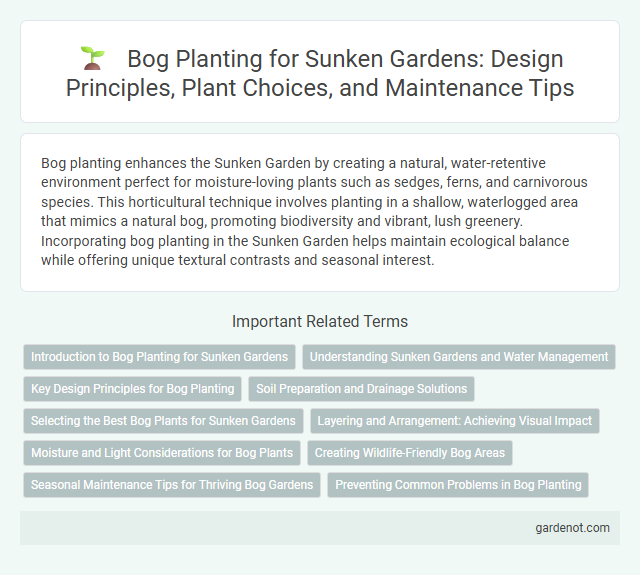Bog planting enhances the Sunken Garden by creating a natural, water-retentive environment perfect for moisture-loving plants such as sedges, ferns, and carnivorous species. This horticultural technique involves planting in a shallow, waterlogged area that mimics a natural bog, promoting biodiversity and vibrant, lush greenery. Incorporating bog planting in the Sunken Garden helps maintain ecological balance while offering unique textural contrasts and seasonal interest.
Introduction to Bog Planting for Sunken Gardens
Bog planting in sunken gardens involves cultivating moisture-loving plants in water-retentive soil conditions that mimic natural wetlands. Key species include bog rosemary, marsh marigold, and carnivorous plants like sundews, which thrive in acidic, nutrient-poor substrates. Proper drainage control and consistent moisture levels are essential to maintain the unique ecosystem characteristic of successful bog planting in these garden designs.
Understanding Sunken Gardens and Water Management
Sunken gardens utilize bog planting to create a natural water-retentive environment essential for moisture-loving plants like carnivorous species and moisture-tolerant perennials. Effective water management in these gardens involves maintaining consistent soil moisture through careful irrigation and drainage systems that prevent waterlogging while promoting oxygen availability to plant roots. Selecting native bog plants adapted to fluctuating water levels enhances ecological balance and reduces maintenance efforts in sunken garden landscapes.
Key Design Principles for Bog Planting
Bog planting requires selecting moisture-loving plants such as sedges, marsh marigolds, and bog moss that thrive in consistently damp, acidic soils with poor drainage. Maintaining waterlogged conditions by incorporating layers of sand, peat, and clay ensures an environment suitable for bog plant root systems and mimics natural bog habitats. Strategic placement of plants in clusters allows for optimal growth, promotes biodiversity, and enhances the aesthetic appeal of a sunken garden's bog area.
Soil Preparation and Drainage Solutions
Bog planting requires soil preparation with highly organic, acidic substrates such as peat moss, coconut coir, or sphagnum moss to retain moisture while maintaining aeration. Effective drainage solutions involve layering coarse sand or gravel beneath the soil to prevent water stagnation and simulate natural bog conditions. Ensuring persistent moisture with adequate water retention and proper drainage is vital for thriving bog plants in sunken gardens.
Selecting the Best Bog Plants for Sunken Gardens
Choosing the best bog plants for sunken gardens involves selecting species that thrive in consistently moist, acidic soil with partial to full shade. Popular options include carnivorous plants like Sarracenia and Drosera, moisture-loving perennials such as Astilbe and Marsh Marigold, and ornamental grasses like Carex species that enhance texture and color. Incorporating native bog plants supports local ecosystems, promotes biodiversity, and ensures better adaptability and longevity in sunken garden environments.
Layering and Arrangement: Achieving Visual Impact
Layering in bog planting creates depth by arranging plants of varying heights and textures, enhancing the Sunken Garden's naturalistic appeal. Strategically positioning moisture-loving plants such as Sphagnum moss, carnivorous species, and sedges ensures both aesthetic diversity and ecological balance. Thoughtful arrangement emphasizes color contrast and seasonal interest, maximizing visual impact while maintaining optimal bog conditions.
Moisture and Light Considerations for Bog Plants
Bog planting requires consistently moist soil to mimic the natural wet habitat essential for bog plants' survival and growth. These plants thrive in partial to full sunlight, with species-specific preferences ranging from shade-tolerant to sun-loving varieties. Maintaining high humidity and avoiding waterlogged conditions ensures optimal moisture balance and prevents root rot in bog garden environments.
Creating Wildlife-Friendly Bog Areas
Bog planting involves selecting moisture-loving plants such as sedges, bog mosses (Sphagnum), and carnivorous species like sundews to create wildlife-friendly bog areas. These plants provide essential habitats and food sources for amphibians, insects, and birds, promoting biodiversity within the sunken garden ecosystem. Maintaining consistent water levels and acidity replicates natural bog conditions necessary for thriving native wildlife populations.
Seasonal Maintenance Tips for Thriving Bog Gardens
Bog planting thrives with consistent seasonal maintenance, including removing dead or decaying plant material in early spring to prevent fungal growth and improve air circulation. Regularly monitoring water levels ensures the soil remains moist but not waterlogged, crucial for the health of bog plants like Sphagnum moss, skunk cabbage, and carnivorous species. Late summer trimming of overgrown foliage encourages new growth while reducing competition among plants, promoting a lush and vibrant bog garden.
Preventing Common Problems in Bog Planting
Proper site selection with consistent moisture and good drainage is crucial to prevent common problems in bog planting. Using native bog plants like Sarracenia and Drosera can reduce susceptibility to pests and diseases. Regular monitoring for molds, root rot, and nutrient imbalances ensures a healthy bog garden environment.
Bog planting Infographic

 gardenot.com
gardenot.com